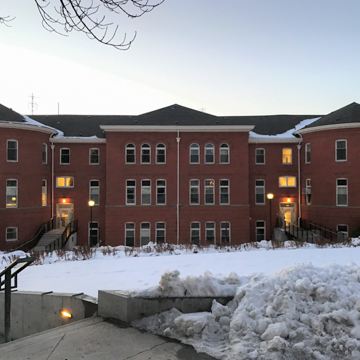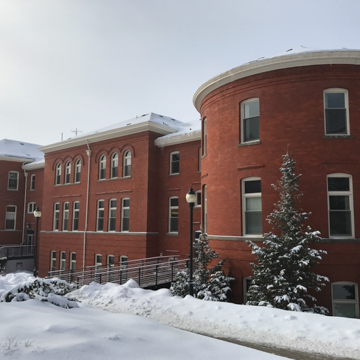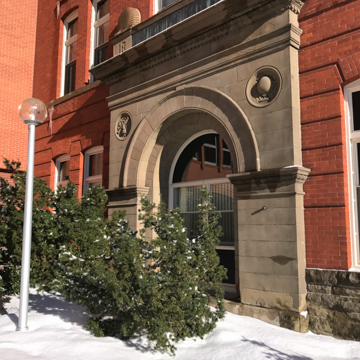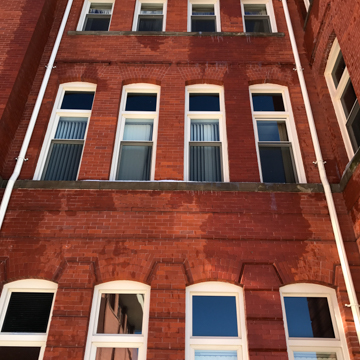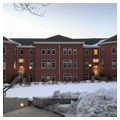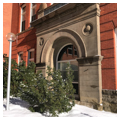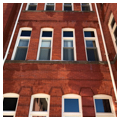You are here
Murrow Hall
An excellent example of the relatively spare yet dignified red brick structures that characterize the historic core of Washington State University, Murrow Hall (originally Science Hall) helped mark the eastern border of an original campus quadrangle-like space. A sandstone triumphal arch, which remains today, faced boldly towards the city—a hopeful 1899 date still chiseled in stone on an entablature below beehive-like capitals. The building, however, was not complete until June 1900, at which point the Evergreen student newspaper declared it “without doubt…the most imposing [building] on the grounds.” The term “imposing” to describe architecture in the late nineteenth century generally held more positive connotations than it does today, and early photographs of the loosely classical building certainly suggest the building’s prepossessing appearance. It is the third-oldest surviving building on campus.
A new building for science was deemed crucial as early as 1896 to house the college’s bourgeoning research in the biological sciences and geology, as well as to provide temporary space for the departments of Agriculture, Veterinary Science, and Horticulture. The construction of such a building was important enough that the Board of Regents allocated $60,000 for its design and construction even before it provided funding to rebuild the Ferry Hall dormitory, the only residence hall on campus, which had burned in an 1897 fire.
College president Enoch A. Bryan set the specifications for a new science building, which called for a 160-foot-long, three-story structure with the top floor dedicated to “museums.” Although Bryan favored the plans of Timotheus Josenhans (he had already been involved in the design of the new Administration Building and Women’s Dormitory for the college), the regents awarded the commission to George W. Bullard of Tacoma—apparently Bullard’s verbal presentation, not his drawings, convinced the selection committee. Upon completion, however, Bryan acknowledged that the new science building was perfectly “satisfactory” and “adapted for the purpose.” The top floor was outfitted with animal exhibits, prepared by taxidermists.
The overall design was not elaborate, but either the need to fit “flatiron microscope tables” into the building laboratories or the desire to capture the best natural light for microscopes dictated the half-cylinder volumes—and possibly the convex windows—on the northern and southern ends of the eastern facade. With the original entrance arch filled with a window and the entire west facade largely obscured from view by the 1972 Jackson Hall addition, the half-cylinders offer the building’s most pronounced exterior feature. Today, Murrow Hall provides enclosure to the major axis of central campus at the western end of the Glenn Terrell Pedestrian Mall, and its most frequented entrances are via pedestrian bridges leading from a landscaped area below the mall.
Murrow Hall features five distinct bays along each of its eastern and western facades, two of which, on either side of the central bay, are slightly recessed. Only the northern recessed bay on the western side is no longer visible, as it now receives a two-story connecting bridge from Jackson Hall to its west. Murrow Hall does feature a tripartite elevation of sorts, as the double-hung windows on each level are framed either by stylized rustication on the first floor, a segmental arch and a floating lintel on the second floor, or round arches on the third floor. The building features a cornice with dentils, and several chimneys originally graced the roofs—necessary to assist with ventilation for the laboratories. Low-slung, hipped roofs aid in rainwater runoff, which funnel into downspouts with decorative leader heads.
The original interiors included botany and zoology laboratories on the northeast side and an operating room for the veterinary students on the south. A 175-seat amphitheater with elevated seats, also on the south side of the building, was a principal feature of the interior—possibly intended for demonstrations of operating procedures in the manner of the great anatomical theaters of sixteenth-century Italy. Traces of these original functions are difficult to recover, as the building has long been altered for offices and studios, including that of the newsroom for the Daily Evergreen student newspaper on the first floor.
Science Hall became “Arts Hall” in the 1930s, and its science-oriented functions, as well as its collection of taxidermy displays were moved over to “New Science Hall” (now Abelson Hall) in 1935. The Department of Communication moved into Arts Hall in 1964, sharing space with the Fine Arts Department until 1968. In the 1970s, the building underwent an interior remodel to accommodate the communications department, which included the removal of wooden wainscoting and floors. The building was renamed during this time after award-winning broadcaster Edward R. Murrow, who attended Washington State College as an undergraduate in the late 1920s.
Murrow Hall may no longer be the university’s most “imposing” building—regardless of the connotations of its imposition. Its original main facade is today obscured by the mostly windowless (and arguably more imposing) Jackson Hall to its immediate west and divided nearly in half by a two-story connecting bridge and entrance. While its cylindrical wings on the east provide a distinctive feature, the building slopes away from the western edge of the Terrell Mall and, viewed from the east, appears sunken into the hillside even while it helps terminate the axis.
However, Murrow Hall is prominent among the original collection of similarly scaled, red brick buildings that outlined a spacious quad-like expanse and helped establish the still-young land grant college as a research institution. For what was a “school of science” as well as a college of agriculture, the original Science Hall was a vital addition to the physical landscape. Its various interior conversions have helped serve the changing needs of the university for well over a century.
Writing Credits
If SAH Archipedia has been useful to you, please consider supporting it.
SAH Archipedia tells the story of the United States through its buildings, landscapes, and cities. This freely available resource empowers the public with authoritative knowledge that deepens their understanding and appreciation of the built environment. But the Society of Architectural Historians, which created SAH Archipedia with University of Virginia Press, needs your support to maintain the high-caliber research, writing, photography, cartography, editing, design, and programming that make SAH Archipedia a trusted online resource available to all who value the history of place, heritage tourism, and learning.














